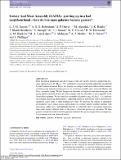Files in this item
Galaxy And Mass Assembly (GAMA) : growing up in a bad neighbourhood - how do low-mass galaxies become passive?
Item metadata
| dc.contributor.author | Davies, L. J. M. | |
| dc.contributor.author | Robotham, A. S. G. | |
| dc.contributor.author | Driver, S. P. | |
| dc.contributor.author | Alpaslan, M. | |
| dc.contributor.author | Baldry, I. K. | |
| dc.contributor.author | Bland-Hawthorn, J. | |
| dc.contributor.author | Brough, S. | |
| dc.contributor.author | Brown, M. J. I. | |
| dc.contributor.author | Cluver, M. E. | |
| dc.contributor.author | Holwerda, B. W. | |
| dc.contributor.author | Hopkins, A. M. | |
| dc.contributor.author | Lara-López, M. A. | |
| dc.contributor.author | Mahajan, S. | |
| dc.contributor.author | Moffett, A. J. | |
| dc.contributor.author | Owers, M. S. | |
| dc.contributor.author | Phillipps, S. | |
| dc.date.accessioned | 2018-01-22T13:30:08Z | |
| dc.date.available | 2018-01-22T13:30:08Z | |
| dc.date.issued | 2016-02-01 | |
| dc.identifier | 252099423 | |
| dc.identifier | 98f4a731-cb38-4266-ae3b-20bbd77bbfc8 | |
| dc.identifier | 84959097451 | |
| dc.identifier | 000368009300050 | |
| dc.identifier.citation | Davies , L J M , Robotham , A S G , Driver , S P , Alpaslan , M , Baldry , I K , Bland-Hawthorn , J , Brough , S , Brown , M J I , Cluver , M E , Holwerda , B W , Hopkins , A M , Lara-López , M A , Mahajan , S , Moffett , A J , Owers , M S & Phillipps , S 2016 , ' Galaxy And Mass Assembly (GAMA) : growing up in a bad neighbourhood - how do low-mass galaxies become passive? ' , Monthly Notices of the Royal Astronomical Society , vol. 455 , no. 4 , pp. 4013-4029 . https://doi.org/10.1093/mnras/stv2573 | en |
| dc.identifier.issn | 0035-8711 | |
| dc.identifier.other | ArXiv: http://arxiv.org/abs/1511.02245v1 | |
| dc.identifier.uri | https://hdl.handle.net/10023/12565 | |
| dc.description.abstract | Both theoretical predictions and observations of the very nearby Universe suggest that low-mass galaxies(log10[M*/M⊙] < 9.5) are likely to remain star-forming unless they are affected by their local environment. To test this premise, we compare and contrast the local environment of both passive and star-forming galaxies as a function of stellar mass, using the Galaxy and Mass Assembly survey. We find that passive fractions are higher in both interacting pair and group galaxies than the field at all stellar masses, and that this effect is most apparent in the lowest mass galaxies. We also find that essentially all passive log10[M*/M⊙] < 8.5 galaxies are found in pair/group environments, suggesting that local interactions with a more massive neighbour cause them to cease forming new stars. We find that the effects of immediate environment (local galaxy–galaxy interactions) in forming passive systems increase with decreasing stellar mass, and highlight that this is potentially due to increasing interaction time-scales giving sufficient time for the galaxy to become passive via starvation. We then present a simplistic model to test this premise, and show that given our speculative assumptions, it is consistent with our observed results. | |
| dc.format.extent | 6417061 | |
| dc.language.iso | eng | |
| dc.relation.ispartof | Monthly Notices of the Royal Astronomical Society | en |
| dc.subject | Galaxies: evolution | en |
| dc.subject | Galaxies: interactions | en |
| dc.subject | QB Astronomy | en |
| dc.subject | QC Physics | en |
| dc.subject | 3rd-DAS | en |
| dc.subject.lcc | QB | en |
| dc.subject.lcc | QC | en |
| dc.title | Galaxy And Mass Assembly (GAMA) : growing up in a bad neighbourhood - how do low-mass galaxies become passive? | en |
| dc.type | Journal article | en |
| dc.contributor.institution | University of St Andrews. School of Physics and Astronomy | en |
| dc.identifier.doi | https://doi.org/10.1093/mnras/stv2573 | |
| dc.description.status | Peer reviewed | en |
This item appears in the following Collection(s)
Items in the St Andrews Research Repository are protected by copyright, with all rights reserved, unless otherwise indicated.

